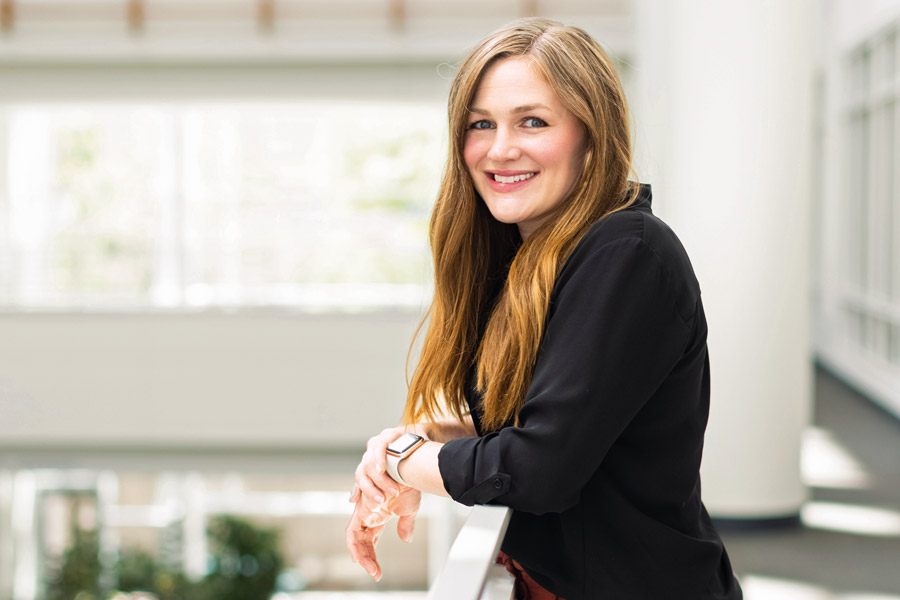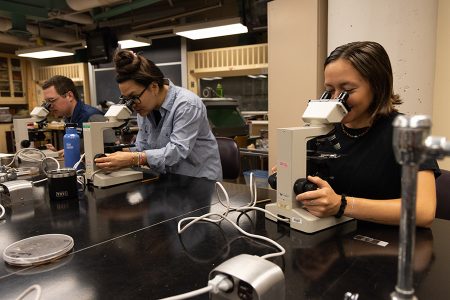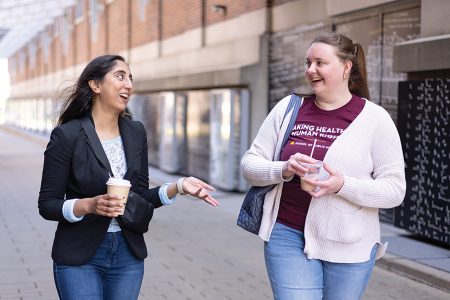Kate Awsumb graduated from the University of Minnesota in 2010 with an MPH in Community Health Communication and an MA in Health Communications, and after graduate school, she worked as a health communications manager at the Centers for Disease Control and Prevention (CDC) for five years.

When she assumed the role of deputy communications director with the Minnesota Department of Health (MDH) in 2016, she had no idea the challenges 2020 would bring.
We sat down with Awsumb to learn about what the past 18 months have been like as a communicator during the biggest public health crisis in most of our lifetimes.
How would you describe this past year, professionally and personally?
It’s been grueling. Communicating about COVID is the biggest challenge of our careers as health communicators, from all of the scientific intricacies to the evolving information, changing recommendations and, of course, the incredibly polarized world that we’re sending all of our messages out into. We joke that half the state hates us because we’re doing too much, and the other half because we’re doing too little.
Personally, it’s an interesting experience to be living what you’re working on. I’d spend hours aligning our messaging and content around testing for COVID, for example, and then later spend hours poring over the MDH website, scrambling to find places to get my kids tested. I’d be updating our website about long COVID, while also scanning our family calendar for my husband’s parade of medical appointments for his long COVID. It’s that intersection of work and life that a lot of us are experiencing every day.
What were the critical messages this year and do you think you got them across to Minnesotans?
Our key messages have always been to wear a mask, stay home if you’re sick or exposed, get tested, and get vaccinated. The overarching message throughout the pandemic is that we’re all in this together. Our health is connected. I think we’ve fallen short with that, but it’s hard to know if it’s our message or the cultural and political context in which it’s received.
Also, I imagine it’s natural for people to think that when recommendations and guidance change, it’s because we were wrong initially, when, really, we’re making the best recommendation that we can with the information we have. I wish we’d done more to help people understand that this is a normal evolution of the scientific process.
There’s been rising awareness of the public health impacts of structural racism in everything from housing to healthcare. How is MDH incorporating these insights into COVID messaging and outreach?
As Lieutenant Governor Peggy Flannagan says, “Nothing about us without us.” That’s been key in our work. We’re funding organizations within communities, not to disseminate our messages, but to really co-create messaging. We have teams dedicated to working with community organizations and other service providers who really know communities best. We include diverse media partners in our media briefings, and we fund partners to provide information in other languages in a timely manner so it makes sense to different communities.
“The overarching message throughout the pandemic is that we’re all in this together. Our health is connected.”
Kate Awsumb
We’ve also held testing and vaccination events in neighborhoods that have seen the impact of racism. For example, we held a number of events near the protest site after the murder of George Floyd. We make sure that we’re in places and spaces that feel safe and known to communities.
We created a statewide network of COVID community hubs and looked at them in a holistic way. They might address vaccination or testing needs, but also gaps in housing, employment, and food security. We work with these organizations that already have the trust of their own communities, because we can’t always expect people to navigate and trust our systems.
What are the difficulties in communicating about public health, in general, and did those things get magnified during the pandemic?
If we’re doing our jobs well, our work is invisible. It can be hard to show the value of something you can’t see, such as the lack of something bad happening. That’s especially difficult in a pandemic — it’s hard to explain how this is really bad, but if we didn’t have some of these recommendations or interventions (masks, distancing, etc.) how much worse it could be.
Then there’s the increasingly pervasive lack of trust in government, science, and experts, and the rise of alternative voices and rampant misinformation that make it a difficult field in which to drop messages. We’re challenged by the basic level of scientific literacy — how the scientific process works, and why adapting and changing messages are all a normal part of science and how it’s supposed to work.
The speed at which the pandemic has moved — and the novelty — have made it difficult to collect data about how well interventions work, and to some extent it would help if we had more concrete things to point to. That would help some people, but there are others who are susceptible to misinformation even in areas where we do have data that something works. They’re still skeptical or don’t find it compelling because it doesn’t fit their worldview.
One lesson we’ve learned is we’ve always had this uneven prioritization of communications within public health. We hope that COVID has helped folks see that communications is a core part of public health, not something we can just layer on top. It’s integral to the process from the beginning. The pandemic has made it clear that communications is right in line with the lab and epidemiology and all the other pieces. We need communications embedded early on in all of that to make it work.
What are the ongoing challenges with delta and other variants to come?
It feels like as soon as we get a handle on what we’re working with, things change and we’re back at… I won’t say square one, but square two. We’ve had to change recommendations, and that’s hard, especially for those who started to see the light at the end of the tunnel. This thing’s not over.
We realized that there may be ups and downs and times when we all really need to crack down, and then times when we can loosen up a bit. It’s not always a linear process. But that’s hard to communicate, and it’s hard for people to know what to do with those messages. I worry that each time there’s an up followed by a down we run the risk of losing people who were previously on board, but every time they go up and down on this rollercoaster ride, they lose a little faith in us or they’re just so exhausted that they stop following the recommendations.
We have to keep listening to the conversations happening around us so we can get the pulse of where people are and adjust our messages. We’ve had practice being nimble, and that will be important in the coming phases of the pandemic. Our team had to rely heavily on our risk communications training — tell people what you know, what you don’t know, and what you’re doing to find out.
We know we’re not going to wake up and find COVID “over,” but we’re starting to think about what the world looks like where COVID co-exists with other public health priorities. And we have to think about how we can rebuild the public’s trust, which has taken hits throughout this. It’s going to be a wild ride.
How do you deal with potential “message fatigue” when COVID messages are so crucial?
That question becomes more and more important as this thing goes on. We’re all sick of COVID, and the longer it goes on, the more of that message fatigue we’re battling. People are emotionally exhausted and ready to move on. We have the core ways that we communicate: through our website, through social media, relationships with the news media partners, etc. We try to switch up the tools we use — the formats, angles, and messengers.
We try to tell and amplify personal stories when we hear them. We try to support health care providers with information. We know that’s a really important source of decision-making for a lot of people. We’ve tried to encourage one-on-one conversations with family and friends, having folks who understand the messages share them with others. That’s how people decide if they should get tested or get vaccinated.
We also appeal to different motivations, because the same things don’t motivate everyone. Some want to do their civic duty to protect the community, while others are more likely to make decisions based on practical things — what will keep my business open, or my kid in school? We have to change it up so we can strike a chord with each person in a different way.


